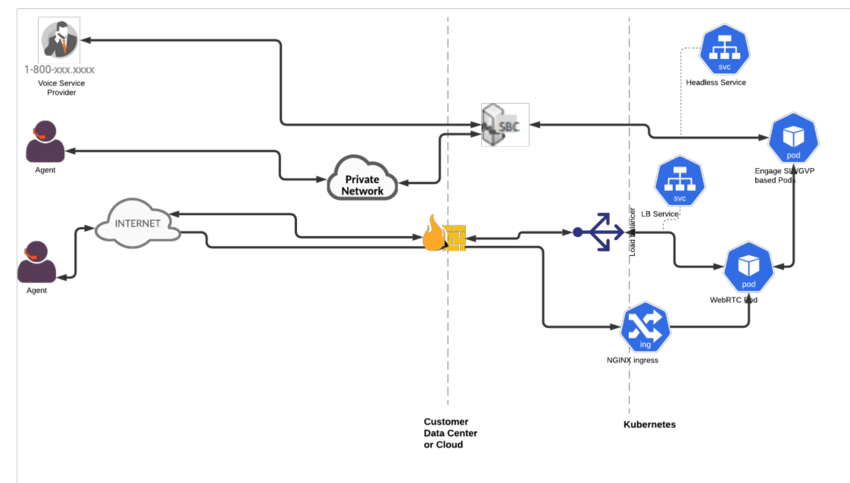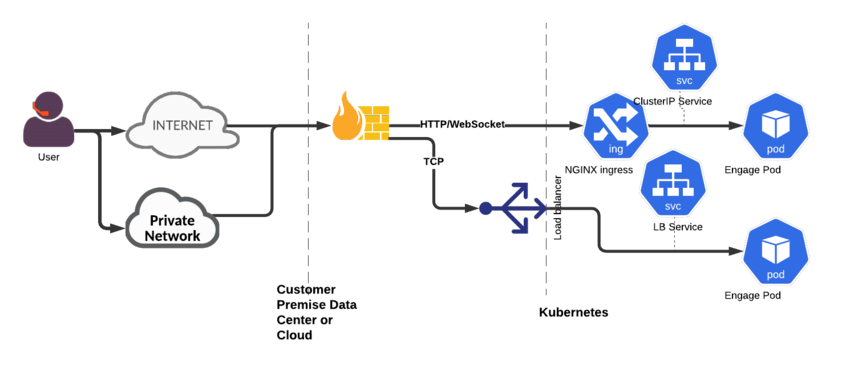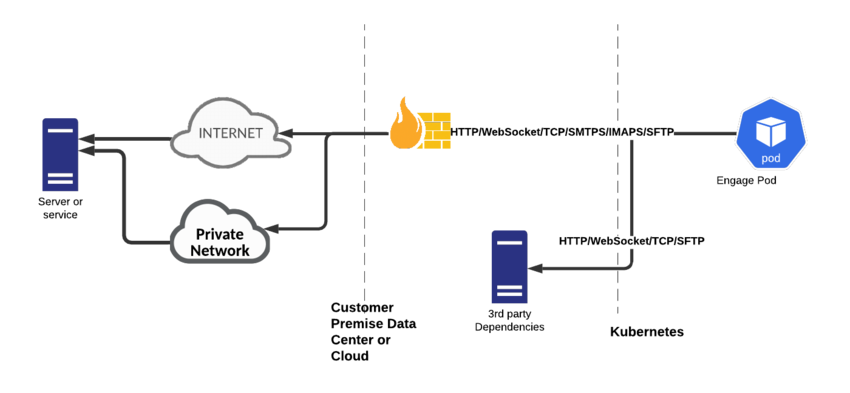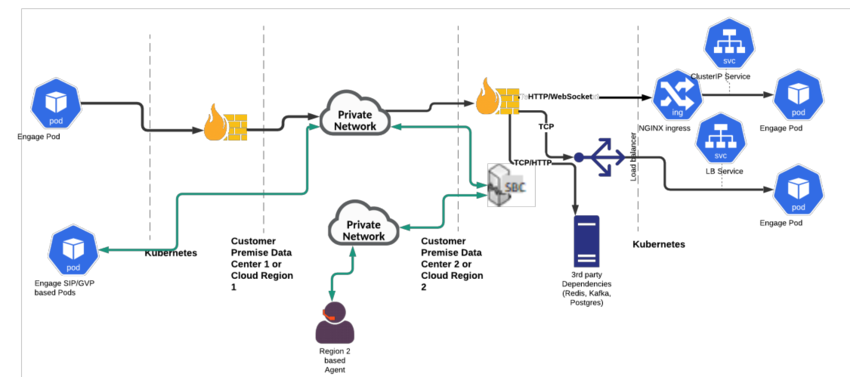Difference between revisions of "PrivateEdition/Current/PEGuide/NetworkOverview"
(Published) |
m (Text replacement - "Genesys Engage" to "Genesys Multicloud CX") |
||
| Line 18: | Line 18: | ||
===Data=== | ===Data=== | ||
| − | Your network must include network elements to control the ingress and egress data traffic between the outside world and the Genesys | + | Your network must include network elements to control the ingress and egress data traffic between the outside world and the Genesys Multicloud CX services running in Kubernetes. However, '''you are responsible for determining how to manage access to the Genesys Multicloud CX services'''. |
The following items are optional, and are shown as examples of how you can control network access. | The following items are optional, and are shown as examples of how you can control network access. | ||
| Line 26: | Line 26: | ||
*'''WAF for HTTP and''' WebSocket—Provides DDOS protection and being able to terminate TLS at the edge of the network. It is also a control point for monitoring traffic. | *'''WAF for HTTP and''' WebSocket—Provides DDOS protection and being able to terminate TLS at the edge of the network. It is also a control point for monitoring traffic. | ||
*'''Firewall for non-HTTP traffic (TCP/UDP)'''—Provides network access control (allowlisting, and so on) and a control point for monitoring the traffic. All egress traffic to internet destinations must use VNet-defined or subnet-defined UDR to route traffic through the Palo Alto Network firewalls. | *'''Firewall for non-HTTP traffic (TCP/UDP)'''—Provides network access control (allowlisting, and so on) and a control point for monitoring the traffic. All egress traffic to internet destinations must use VNet-defined or subnet-defined UDR to route traffic through the Palo Alto Network firewalls. | ||
| − | *'''API Gateway'''—Enables you to control application and system access to the Genesys | + | *'''API Gateway'''—Enables you to control application and system access to the Genesys Multicloud CX APIs from the standpoint of rate limiting and authorization |
'''Egress:''' | '''Egress:''' | ||
| Line 70: | Line 70: | ||
*'''Regional SBCs'''—For optimizing RTP connections when calls are crossing regions | *'''Regional SBCs'''—For optimizing RTP connections when calls are crossing regions | ||
| − | *'''Kubernetes clusters'''—For Genesys | + | *'''Kubernetes clusters'''—For Genesys Multicloud CX service-to-service communication |
| − | *'''Third-party dependency clusters'''—For Genesys | + | *'''Third-party dependency clusters'''—For Genesys Multicloud CX services to communicate with the clusters in other regions (such as Kafka, Redis, and Postgres) |
The network infrastructure must have the following characteristics: | The network infrastructure must have the following characteristics: | ||
Revision as of 21:13, November 9, 2021
Contents
Learn about the network access types for voice and data traffic, and the network elements involved in their architecture. For Kubernetes cluster related network settings, see Network settings.
Network access types
There are two types of access to the platform from a tenant perspective:
- Voice—Voice (SIP/RTP) traffic
- Data—Data traffic.
Voice
The architecture supports SBC integration for both carrier and agent phones, and WebRTC phone access over a data network. The architecture of this voice network is up to you.

Data
Your network must include network elements to control the ingress and egress data traffic between the outside world and the Genesys Multicloud CX services running in Kubernetes. However, you are responsible for determining how to manage access to the Genesys Multicloud CX services.
The following items are optional, and are shown as examples of how you can control network access.
Ingress:
- WAF for HTTP and WebSocket—Provides DDOS protection and being able to terminate TLS at the edge of the network. It is also a control point for monitoring traffic.
- Firewall for non-HTTP traffic (TCP/UDP)—Provides network access control (allowlisting, and so on) and a control point for monitoring the traffic. All egress traffic to internet destinations must use VNet-defined or subnet-defined UDR to route traffic through the Palo Alto Network firewalls.
- API Gateway—Enables you to control application and system access to the Genesys Multicloud CX APIs from the standpoint of rate limiting and authorization
Egress:
- Firewall for all external traffic—Provides network access control (allowlisting, and so on) and a control point for monitoring traffic, to support the security and compliance requirements of your business
Ingress
This architecture uses the following data-related ingress connections:
- HTTP(S)
- WebSocket
- TCP
You must make sure that the right network infrastructure is in place to support your security needs. For more information about the ingress controller and load balancer configurations, see the appropriate service-level guides.

Egress
This architecture uses the following data-related external egress connections:
- HTTPS
- TCP
- SFTP
- IMAPS/SMTPS
You must make sure that the right network infrastructure is in place to support your security needs.

Cross-Region traffic
This architecture uses the following data-related connections:
- HTTP
- TCP
- SIP/RTP
You must ensure that you have network infrastructure that allows communication between the following:
- Regional SBCs—For optimizing RTP connections when calls are crossing regions
- Kubernetes clusters—For Genesys Multicloud CX service-to-service communication
- Third-party dependency clusters—For Genesys Multicloud CX services to communicate with the clusters in other regions (such as Kafka, Redis, and Postgres)
The network infrastructure must have the following characteristics:
- Low latency—To allow for its use by voice traffic
- Medium bandwidth

